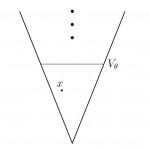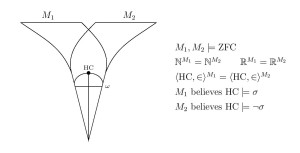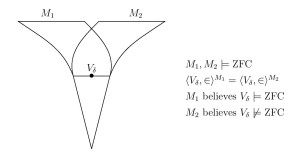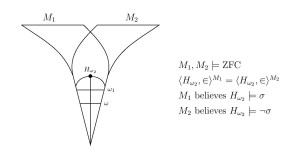![Holzschnitt aus Camille Flammarion: L'Atmosphere - Météorologie Populaire. Paris 1888. Kolorierung : Heikenwaelder Hugo, Wien 1998. Email : heikenwaelder@aon.at, www.heikenwaelder.at [CC BY-SA 2.5 (http://creativecommons.org/licenses/by-sa/2.5)], via Wikimedia Commons Universum](http://jdh.hamkins.org/wp-content/uploads/2017/04/Universum-300x234.jpg) I recently came to realize that worldly cardinals are not necessarily downward absolute to transitive inner models. That is, it can happen that a cardinal is worldly in the full set-theoretic universe , but not in some transitive inner model , even when is itself a model of ZFC. The observation came out of some conversations I had with Alexander Block from Hamburg during his recent research visit to New York. Let me explain the argument.
I recently came to realize that worldly cardinals are not necessarily downward absolute to transitive inner models. That is, it can happen that a cardinal is worldly in the full set-theoretic universe , but not in some transitive inner model , even when is itself a model of ZFC. The observation came out of some conversations I had with Alexander Block from Hamburg during his recent research visit to New York. Let me explain the argument.
A cardinal is inaccessible, if it is an uncountable regular strong limit cardinal. The structure , consisting of the rank-initial segment of the set-theoretic universe up to , which can be generated from the empty set by applying the power set operation many times, has many nice features. In particular, it is transitive model of . The models for inaccessible are precisely the uncountable Grothendieck universes used in category theory.
Although the inaccessible cardinals are often viewed as the entryway to the large cardinal hierarchy, there is a useful large cardinal concept weaker than inaccessibility. Namely, a cardinal is worldly, if is a model of . Every inaccessible cardinal is worldly, and in fact a limit of worldly cardinals, because if is inaccessible, then there is an elementary chain of cardinals with , and all such are worldly. The regular worldly cardinals are precisely the inaccessible cardinals, but the least worldly cardinal is always singular of cofinality .
The worldly cardinals can be seen as a kind of poor-man’s inaccessible cardinal, in that worldliness often suffices in place of inaccessibility in many arguments, and this sometimes allows one to weaken a large cardinal hypothesis. But meanwhile, they do have some significant strengths. For example, if is worldly, then satisfies the principle that every set is an element of a transitive model of .
It is easy to see that inaccessibility is downward absolute, in the sense that if is inaccessible in the full set-theoretic universe and is a transitive inner model of , then is also inaccessible in . The reason is that cannot be singular in , since any short cofinal sequence in would still exist in ; and it cannot fail to be a strong limit there, since if some had -many distinct subsets in , then this injection would still exist in . So inaccessibility is downward absolute.
The various degrees of hyper-inaccessibility are also downwards absolute to inner models, so that if is an inaccessible limit of inaccessible limits of inaccessible cardinals, for example, then this is also true in any inner model. This downward absoluteness extends all the way through the hyperinaccessibility hierarchy and up to the Mahlo cardinals and beyond. A cardinal is Mahlo, if it is a strong limit and the regular cardinals below form a stationary set. We have observed that being regular is downward absolute, and it is easy to see that every stationary set is stationary in every inner model, since otherwise there would be a club set disjoint from in the inner model, and this club would still be a club in . Similarly, the various levels of hyper-Mahloness are also downward absolute.
So these smallish large cardinals are generally downward absolute. How about the worldly cardinals? Well, we can prove first off that worldliness is downward absolute to the constructible universe .
Observation. If is worldly, then it is worldly in .
Proof. If is worldly, then . This implies that is a beth-fixed point. The of , which is a model of , is precisely , which is also the of , since must also be a beth-fixed point in . So is worldly in . QED
But meanwhile, in the general case, worldliness is not downward absolute.
Theorem. Worldliness is not necessarily downward absolute to all inner models. It is relatively consistent with that there is a worldly cardinal and an inner model , such that is not worldly in .
Proof. Suppose that is a singular worldly cardinal in . And by forcing if necessary, let us assume the GCH holds in . Let be the forcing extension where we perform the Easton product forcing , so as to force a violation of the GCH at every regular cardinal . So the stage forcing is .
First, I shall prove that is worldly in the forcing extension . Since every set of rank less than is added by some stage less than , it follows that is precisely . Most of the axioms hold easily in ; the only difficult case is the collection axiom. And for this, by considering the ranks of witnesses, it suffices to show for every that every function that is definable from parameters in is bounded. Suppose we have such a function, defined by just in case holds in . Let be larger than the rank of . Now consider , which is a set-forcing extension of and therefore a model of . The fail forcing, from stage up to , is homogeneous in this model. And therefore we know that just in case forces , since these arguments are all in the ground model . So the function is already definable in . Because this is a model of , the function is bounded below . So we get the collection axiom in and hence all of there, and so is worldly in .
For any , let be the restriction of the Easton product forcing to include only the stages in , and let be the corresponding generic filter. The full forcing factors as , and so is a transitive inner model of .
But if we pick to be a short cofinal set in , which is possible because is singular, then will not be worldly in the inner model , since in we will be able to identify that sequence as the places where the GCH fails. So is not worldly in .
In summary, was worldly in , but not in the transitive inner model , and so worldliness is not downward absolute. QED
![Holzschnitt aus Camille Flammarion: L'Atmosphere - Météorologie Populaire. Paris 1888. Kolorierung : Heikenwaelder Hugo, Wien 1998. Email : heikenwaelder@aon.at, www.heikenwaelder.at [CC BY-SA 2.5 (http://creativecommons.org/licenses/by-sa/2.5)], via Wikimedia Commons Universum](http://jdh.hamkins.org/wp-content/uploads/2017/04/Universum-300x234.jpg) I recently came to realize that worldly cardinals are not necessarily downward absolute to transitive inner models. That is, it can happen that a cardinal
I recently came to realize that worldly cardinals are not necessarily downward absolute to transitive inner models. That is, it can happen that a cardinal 
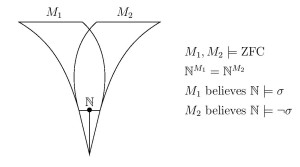 On the basis of these observations, Ruizhi Yang (Fudan University, Shanghai) and I argue that the definiteness of the theory of truth for a structure, even in the case of arithmetic, cannot be seen as arising solely from the definiteness of the structure itself in which that truth resides, but rather is a higher-order ontological commitment.
On the basis of these observations, Ruizhi Yang (Fudan University, Shanghai) and I argue that the definiteness of the theory of truth for a structure, even in the case of arithmetic, cannot be seen as arising solely from the definiteness of the structure itself in which that truth resides, but rather is a higher-order ontological commitment.